The Carbon Emissions and Energy Use of the Indian Hotel Industry
Posted OnWe continue our weekly blog with another post on hospitality, this time, an analysis of the hotel industry in general in India. In 2011, USAID and the Indian government’s Bureau of Energy Efficiency (BEE) commissioned a study by cBalance to understand the energy consumption of hotels in India, analyzing their carbon emissions, energy intensity, and efficiency and mitigation opportunities. The project’s goal, specifically, was to collect energy data for a robust set of hotels and hospitals distributed across all known climatic zones and recognized service-class categories in India to provide adequate data for the development of a statistical benchmarking system for buildings within service class categories of the above sectors based on their normalized energy performance index.
Project Scope:
Data set
Energy data collection was based on the following data groups:
Group 1: Business metrics
- Service class type and size / service capacity
- Area – Campus area, Built-up area, Carpet area, Common area, other use areas – conference area, restaurants etc.
- Overnight occupancy (customers, patients)
- Total occupancy
- Employee strength
Group 2: Energy use
- Purchased electricity
- Captive power generation and associated fuel consumption
- Fuel consumption for steam/water heating
- Fuel consumption for cooking/catering
- Other fuel consumption
- Air Conditioning – installed capacity under all AC technology types
- Lighting Load – installed capacity under all lighting technology types
- Water pumping load – installed capacity under all lighting technology types
- Other plug loads – Equipment, computers etc.
- Sub-metered electricity consumption for AC, lighting, water pumping, plug load equipment, office equipment, electric geysers, kitchen equipment, laundry equipment, swimming pool, elevators, ETP/STP.
- Renewable energy generation – solar PV, solar thermal water heating, waste to energy etc.
- Water and Hot Water consumption.
For this project, 131 hotels across the country in various cities and climatic zones and of various services grades were surveyed . The results are displayed in the following table and map:
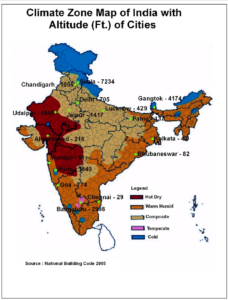
More hotels lie in the warm and humid zone than any other (40), followed by composite (38), temperate (27), cold (25), and hot and dry (17):
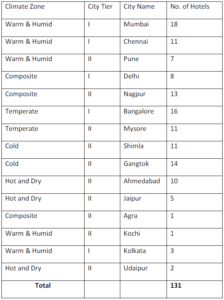
Energy consumption can vary significantly with respect to geographic location, and the following graph displays the results of our data collection:
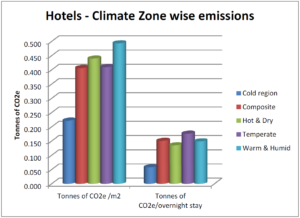
Warm & humid regions consume the most amount of energy per square meter. This is because the high humidity reduces the performance of HVAC systems, requiring more energy to be consumed for cooling. Cold regions, on the other hand, have the lowest emissions because their air conditioning requirements are lower. This illustrates how significant air conditioning is as a portion of a hotel’s total energy consumption.
Energy efficiency also varies a great deal with respect to the service grade of the hotel, as is shown in the next graph:
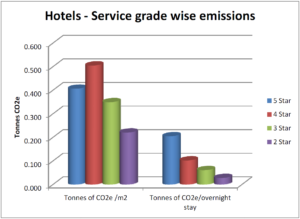
It may seem counter-intuitive that 4 star hotels have higher emissions per square meter, but this is because they don’t use their space as efficiently as the five star hotels nor have invested in newer and greener technologies. Per overnight stay, 5 star hotels have the highest emissions due to the comfort and amenities they provide their customers with.
The following graphs break down the emissions of each service category per climatic zone. The data used below has also been normalized for whether the hotel does laundry in-house or outsources it, as this contributes a significant portion of the energy usage.
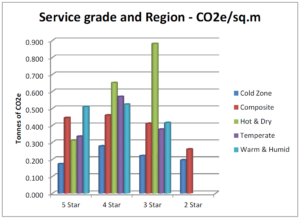
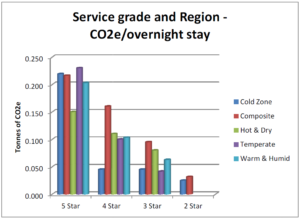
Potential for saving:
We calculated the amount of CO2e emissions that could be saved if all 5 star and 4 star hotels in each climatic zone improved their energy efficiency to that of the top 25% (75th percentile) of their peers:
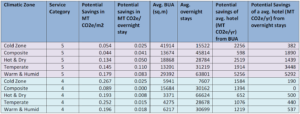
As described in the above table, when measured from the built-up area (BUA), 5 star hotels can achieve a savings of 600 to 5000 tonnes of CO2e per year depending on the region, or 400-5000 tonnes of CO2e when calculating by overnight stay. For 4 star hotels, there is a potential savings of 650 to 1600 tonnes of CO2e and 190-530 tonnes when calculated by BUA and overnight stay, respectively. The largest potential for savings is in 5 stars hotels in warm and humid regions.
Further analysis of data, such as open and enclosed space use and technology interventions, has helped us document best practices in the industry and enabled us to create best practice guidelines for others to follow.
Climate Miles understands the unique requirements and challenges of the hotel industry to provide a high degree of comfort to their customers while keeping its footprint low. We work with clients across India through data driven methods to help them realize their carbon footprints relative to their peers with similar amenities. We also help them become more efficient through a wide array of process optimization and technology interventions with minimum disruption, which not only results in emission reduction but also increases bottom lines through cost savings. Our approach towards greening is to develop property specific or hotel chain specific MAC curves which will guide customers to prioritize their green investment opportunities.
MACC analysis is used for developing greening-roadmaps that transform the operations of institutions and corporations to set them on a low-carbon pathway. This is achieved by empowering them with information related to the ‘low-hanging fruit’ alternatives that must be pursued before embarking upon token or capital-intensive programs to reduce the Climate Change impacts of operational activities. The goal is to demonstrate the inherent alignment between economically prudent and environmentally imperative alternatives and debunk the myth that environmental responsibility reduces profits. If you would like your hotel to become more energy efficient or would like us to help you develop a energy efficiency or sustainability roadmap, please contact Vivek Gilani (Founder/Director of cBalance Solutions Hub) at vivek@cbalance.in
The original study can be read here.